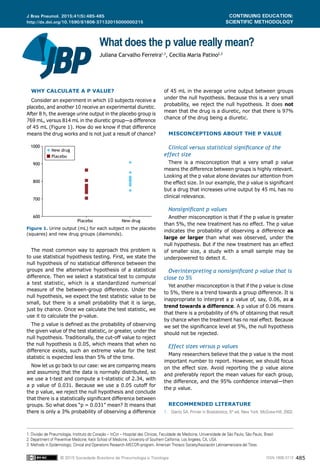
What does the p value really mean?
- 1. ISSN 1806-3713© 2015 Sociedade Brasileira de Pneumologia e Tisiologia http://dx.doi.org/10.1590/S1806-37132015000000215 J Bras Pneumol. 2015;41(5):485-485 Continuing Education: Scientific Methodology 485 What does the p value really mean? Juliana Carvalho Ferreira1,3 , Cecilia Maria Patino2,3 Why calculate a p value? Consider an experiment in which 10 subjects receive a placebo, and another 10 receive an experimental diuretic. After 8 h, the average urine output in the placebo group is 769 mL, versus 814 mL in the diuretic group—a difference of 45 mL (Figure 1). How do we know if that difference means the drug works and is not just a result of chance? of 45 mL in the average urine output between groups under the null hypothesis. Because this is a very small probability, we reject the null hypothesis. It does not mean that the drug is a diuretic, nor that there is 97% chance of the drug being a diuretic. Misconceptions about the p value Clinical versus statistical significance of the effect size There is a misconception that a very small p value means the difference between groups is highly relevant. Looking at the p value alone deviates our attention from the effect size. In our example, the p value is significant but a drug that increases urine output by 45 mL has no clinical relevance. Nonsignificant p values Another misconception is that if the p value is greater than 5%, the new treatment has no effect. The p value indicates the probability of observing a difference as large or larger than what was observed, under the null hypothesis. But if the new treatment has an effect of smaller size, a study with a small sample may be underpowered to detect it. Overinterpreting a nonsignificant p value that is close to 5% Yet another misconception is that if the p value is close to 5%, there is a trend towards a group difference. It is inappropriate to interpret a p value of, say, 0.06, as a trend towards a difference. A p value of 0.06 means that there is a probability of 6% of obtaining that result by chance when the treatment has no real effect. Because we set the significance level at 5%, the null hypothesis should not be rejected. Effect sizes versus p values Many researchers believe that the p value is the most important number to report. However, we should focus on the effect size. Avoid reporting the p value alone and preferably report the mean values for each group, the difference, and the 95% confidence interval—then the p value. Recommended Literature 1. Glantz SA. Primer in Biostatistics, 5th ed. New York: McGraw-Hill; 2002. Figure 1. Urine output (mL) for each subject in the placebo (squares) and new drug groups (diamonds). 1000 900 800 700 600 Placebo New drug Placebo New drug 1. Divisão de Pneumologia, Instituto do Coração – InCor – Hospital das Clínicas, Faculdade de Medicina, Universidade de São Paulo, São Paulo, Brasil. 2. Department of Preventive Medicine, Keck School of Medicine, University of Southern California, Los Angeles, CA, USA. 3. Methods in Epidemiologic, Clinical and Operations Research–MECOR–program, American Thoracic Society/Asociación Latinoamericana del Tórax. The most common way to approach this problem is to use statistical hypothesis testing. First, we state the null hypothesis of no statistical difference between the groups and the alternative hypothesis of a statistical difference. Then we select a statistical test to compute a test statistic, which is a standardized numerical measure of the between-group difference. Under the null hypothesis, we expect the test statistic value to be small, but there is a small probability that it is large, just by chance. Once we calculate the test statistic, we use it to calculate the p-value. The p value is defined as the probability of observing the given value of the test statistic, or greater, under the null hypothesis. Traditionally, the cut-off value to reject the null hypothesis is 0.05, which means that when no difference exists, such an extreme value for the test statistic is expected less than 5% of the time. Now let us go back to our case: we are comparing means and assuming that the data is normally distributed, so we use a t-test and compute a t-statistic of 2.34, with a p value of 0.031. Because we use a 0.05 cutoff for the p value, we reject the null hypothesis and conclude that there is a statistically significant difference between groups. So what does “p = 0.031” mean? It means that there is only a 3% probability of observing a difference